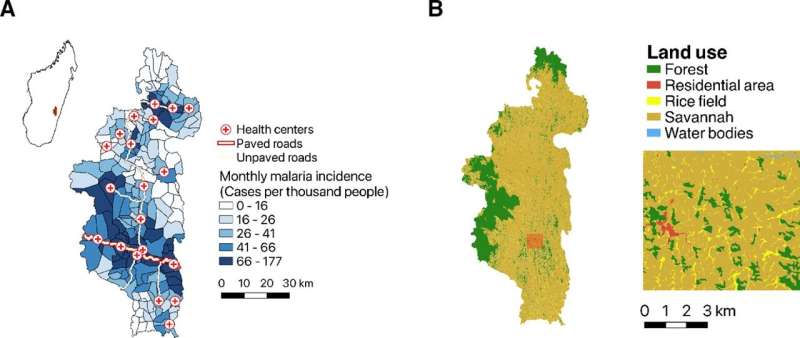This article has been reviewed according to Science X's editorial process and policies. Editors have highlighted the following attributes while ensuring the content's credibility:
fact-checked
peer-reviewed publication
trusted source
proofread
New analysis could help forecast malaria outbreaks

As with COVID, public health agencies around the world have struggled to predict which communities will be hit the hardest with malaria, a life-threatening disease that infected an estimated 247 million people in 2021. A new Stanford-led study done in collaboration with local scientists and health care experts in Madagascar paves the way to using easily obtainable data to accurately predict malaria outbreaks in communities.
The analysis, published Feb. 22 in PLOS Global Public Health, is the first such study to show these relationships in fine detail and could inform efforts to combat malaria more efficiently and affordably.
"We can predict which villages will have the most malaria cases, even when these villages are only a few miles apart," said study lead author Julie Pourtois, a Ph.D. student in biology at the Stanford School of Humanities and Sciences. "These predictions could help distribute limited health care resources where they are most needed, which is particularly valuable in countries with limited access to health care."
Predicting a heavy burden
Nearly half of the world's population was at risk of malaria—an acute febrile illness transmitted by mosquito bites—and approximately 619,000 people died from it in 2021, the most recent year for which the World Health Organization provides such statistics. Its burden falls hardest on people living in poverty impoverished communities in Africa, where children under 5 accounted for about 80% of all malaria deaths in 2021.
While health care agencies have a good sense of what drives malaria at national scales, including warm weather and rain patterns that facilitate mosquito breeding and activity, factors like microclimates and land use make local-scale predictions much more complex and uncertain. Health system data can also provide an inaccurate picture of community burden because people who are less able to access health care are not represented.
In collaboration with Madagascar's national malaria control program and Pivot, a local health care organization, the researchers focused on a region in southeastern Madagascar. They built upon a previous Stanford-led study that looked at malaria incidence data collected by health care centers in the district and adjusted to correct for reporting biases derived from financial and geographic barriers to health care. To this, the researchers combined satellite information on climate, land use maps as well as socioeconomic data from household surveys conducted by the Madagascar National Institute of Statistics.
With this blend of data, the researchers asked which of these variables best explained malaria patterns and trained a model to predict the monthly malaria cases across 195 villages.
The researchers found malaria burden is low in residential areas and high in areas with flooded rice fields, suggesting that malaria is more of a rural disease in the study area—something that's not always true elsewhere. They also found a strong relationship between poverty and reported malaria cases, indicating that many people living in poverty were not getting care at health centers, and making clear the need to improve health care access.
The analysis was able to predict relatively well which villages were going to be hit the hardest with malaria. In fact, the approach correctly identified more than half of communities in the top 20% for malaria transmission, and explained over three-quarters of the variation in malaria incidence rank.
"We have shown that the new generation of satellite and land use data, integrated with socio-economic and public health data gathered on the ground allows to describe heterogeneity in malaria incidence at a very fine spatial scale," said study co-author Giulio De Leo, a professor of oceans and Earth system science in the Stanford Doerr School of Sustainability. "That was impossible until recently."
"This is an important first step towards bringing advances in disease ecology and modeling for disease prediction to local communities in settings that need them the most: those with high burdens of malaria, widespread poverty and low access to health care," said senior author Andres Garchitorena, a researcher at the French Research Institute for Sustainable Development and associate scientific director at Pivot.
More information: Julie D. Pourtois et al, Climatic, land-use and socio-economic factors can predict malaria dynamics at fine spatial scales relevant to local health actors: Evidence from rural Madagascar, PLOS Global Public Health (2023). DOI: 10.1371/journal.pgph.0001607

















